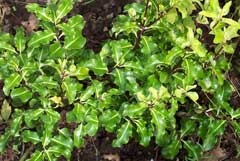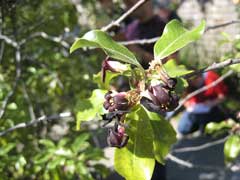 |
|
|
 |
| http://www.flickr.com/photos/62614925@N00 |
Translate this page:
Summary
Physical Characteristics

 Pittosporum tenuifolium is an evergreen Tree growing to 7 m (23ft) by 4 m (13ft) at a medium rate.
Pittosporum tenuifolium is an evergreen Tree growing to 7 m (23ft) by 4 m (13ft) at a medium rate.
See above for USDA hardiness. It is hardy to UK zone 8. It is in leaf all year, in flower in May. The species is hermaphrodite (has both male and female organs) and is pollinated by Insects.
Suitable for: light (sandy) and medium (loamy) soils and prefers well-drained soil. Suitable pH: mildly acid, neutral and basic (mildly alkaline) soils. It can grow in semi-shade (light woodland) or no shade. It prefers dry or moist soil. The plant can tolerate maritime exposure.
UK Hardiness Map
US Hardiness Map
Synonyms
P. mayi. Hort. P. nigricans.
Plant Habitats
Woodland Garden Sunny Edge; Dappled Shade; Hedge;
Edible Uses
Edible Parts:
Edible Uses: Gum
Gum - fragrant. It is obtained by bruising the bark or by incision[128, 173].
References More on Edible Uses
Medicinal Uses
Plants For A Future can not take any responsibility for any adverse effects from the use of plants. Always seek advice from a professional before using a plant medicinally.
None known
References More on Medicinal Uses
The Bookshop: Edible Plant Books
Our Latest books on Perennial Plants For Food Forests and Permaculture Gardens in paperback or digital formats.

Edible Tropical Plants
Food Forest Plants for Hotter Conditions: 250+ Plants For Tropical Food Forests & Permaculture Gardens.
More

Edible Temperate Plants
Plants for Your Food Forest: 500 Plants for Temperate Food Forests & Permaculture Gardens.
More

More Books
PFAF have eight books available in paperback and digital formats. Browse the shop for more information.
Shop Now
Other Uses
Gum Hedge Hedge
Very tolerant of trimming, plants can be grown as a formal or informal hedge in exposed maritime areas, though they do not stand extreme exposure[11, 75, 200]. When grown as a formal hedge it is best trimmed in spring, though this will mean that the plant will not produce many flowers[245]. A compromise is to only trim the hedge every other year[245].
Special Uses
Hedge Hedge Scented Plants
References More on Other Uses
Cultivation details
Succeeds in most well-drained soils of reasonably good quality in full sun or light shade[1, 200]. Succeeds in dry soils. Fairly tolerant of maritime exposure[75, 182], but it can be killed by cold winds[184]. Hardy to about -10°c[184], it is tender outside the milder areas of Britain, but often self-sows when happy. Plants have reached a height of 9 metres in a sheltered position in eastern England[11]. A very ornamental plant[1], there are many named varieties[200]. Very amenable to pruning, plants can be cut right back into old wood if required[200]. The species in this genus are very likely to hybridize with other members of the genus[200]. When growing a species from seed it is important to ensure that the seed either comes from a known wild source, or from isolated specimens in cultivation. Plants are widely cultivated for their foliage which lasts a long time in water and is used in flower arranging[11, 75]. The flowers are honey-scented[188]. Plants in this genus are notably resistant to honey fungus[200].
References Carbon Farming Information and Carbon Sequestration Information
Temperature Converter
Type a value in the Celsius field to convert the value to Fahrenheit:
Fahrenheit:
The PFAF Bookshop
Plants For A Future have a number of books available in paperback and digital form. Book titles include Edible Plants, Edible Perennials, Edible Trees,Edible Shrubs, Woodland Gardening, and Temperate Food Forest Plants. Our new book is Food Forest Plants For Hotter Conditions (Tropical and Sub-Tropical).
Shop Now
Plant Propagation
Seed - sow when ripe in the autumn or in late winter in a warm greenhouse[78, 200]. The seed usually germinates freely. Prick out the seedlings into individual pots when they are large enough to handle, move the plants to a cold frame as soon as they are established and plant out late in the following spring[78]. Consider giving them some protection from the cold during their first winter outdoors. Cuttings of half-ripe wood, 5 - 7cm with a heel, July/August in a frame. Poor to fair percentage[78]. Basal ripewood cuttings late autumn in a cold frame[200].
Other Names
If available other names are mentioned here
Native Range
AUSTRALASIA: New Zealand (North Island, South Island)
Weed Potential
Right plant wrong place. We are currently updating this section.
Please note that a plant may be invasive in one area but may not in your area so it's worth checking.
Conservation Status
IUCN Red List of Threatened Plants Status :

| Related Plants
|
| Latin Name | Common Name | Habit | Height | Hardiness | Growth | Soil | Shade | Moisture | Edible | Medicinal | Other |
| Pittosporum balansae | | Shrub | 3.0 |
-
| | LMH | SN | DM | 1 | 0 | |
| Pittosporum bicolor | Banyalla | Shrub | 5.0 |
8-11
| | LMH | SN | DM | 0 | 0 | 3 |
| Pittosporum crassifolium | Karo, Stiffleaf cheesewood | Shrub | 5.0 |
8-11
| | LM | SN | DM | 0 | 0 | 3 |
| Pittosporum eugenioides | Tarata | Tree | 10.0 |
8-11
| | LM | SN | DM | 1 | 1 | 1 |
| Pittosporum phillyreoides | Weeping Pittosporum, Narrow-leaf Pittosporum | Shrub | 4.5 |
9-11
| S | LM | N | DM | 2 | 1 | 2 |
| Pittosporum ralphii | Ralph's desertwillow | Shrub | 4.0 |
8-11
| | LM | N | DM | 0 | 0 | 3 |
| Pittosporum resiniferum | Petroleum nut | Tree | 25.0 |
10-12
| M | LMH | N | M | 0 | 3 | 4 |
| Pittosporum tobira | Tobira, Japanese cheesewood, Australian Laurel, Mock Orange, Japanese Pittosporum | Shrub | 6.0 |
8-11
| F | LM | SN | DM | 0 | 0 | 3 |
| Pittosporum undulatum | Cheesewood, Australian cheesewood, Cheesewood, Pittosporum, Orange Berry Pittosporum, Victorian Box | Tree | 12.0 |
9-11
| F | LM | SN | DM | 0 | 0 | 3 |
|
Growth: S = slow M = medium F = fast. Soil: L = light (sandy) M = medium H = heavy (clay). pH: A = acid N = neutral B = basic (alkaline). Shade: F = full shade S = semi-shade N = no shade. Moisture: D = dry M = Moist We = wet Wa = water.
Now available:
Food Forest Plants for Mediterranean Conditions
350+ Perennial Plants For Mediterranean and Drier Food Forests and Permaculture Gardens.
[Paperback and eBook]
This is the third in Plants For A Future's series of plant guides for food forests tailored to
specific climate zones. Following volumes on temperate and tropical ecosystems, this book focuses
on species suited to Mediterranean conditions—regions with hot, dry summers and cool, wet winters,
often facing the added challenge of climate change.
Read More
Expert comment
Author
Gaertn.
Botanical References
1144200
Links / References
For a list of references used on this page please go here
Readers comment
| Add a comment |
|
If you have important information about this plant that may help other users please add a comment or link below. Only comments or links that are felt to be directly relevant to a plant will be included. If you think a comment/link or information contained on this page is inaccurate or misleading we would welcome your feedback at [email protected]. If you have questions about a plant please use the Forum on this website as we do not have the resources to answer questions ourselves.
* Please note: the comments by website users are not necessarily those held by PFAF and may give misleading or inaccurate information.
To leave a comment please Register or login here All comments need to be approved so will not appear immediately.
|
Subject : Pittosporum tenuifolium
|
|
|
|